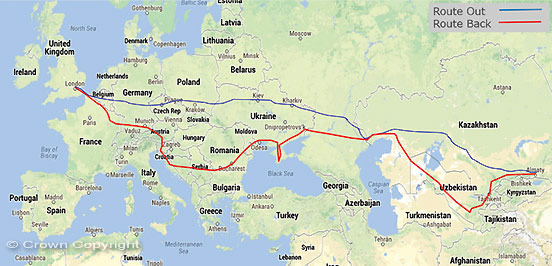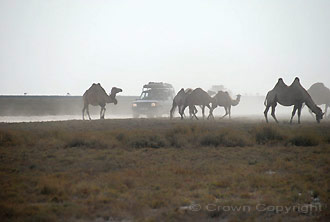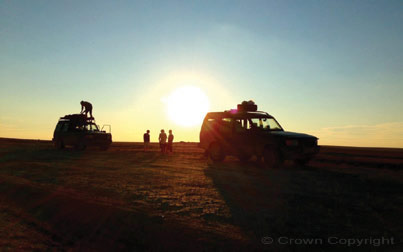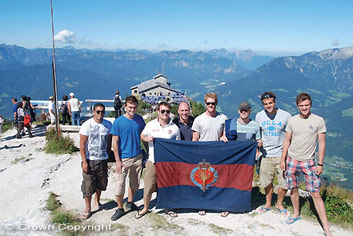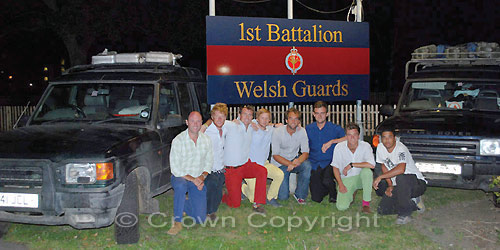Home | About Us | Subscribe | Advertise | Other Publications | Diary | Offers | Gallery | More Features | Obituaries | Contact |
|
|
|
|||||||
Following the Queen’s Birthday Parade, the Welsh Guards deployed on Ex STEPPE EAGLE, forming a 24-man training team as part of a multi-national group tasked with preparing and assessing the Kazakh Army’s airborne brigade. Presented with an opportunity to travel to a part of the world hitherto unvisited, it seemed a good opportunity to expand the exercise into a full scale expedition, to be named Ex SILK DRAGON.
A plan was duly formed for an eight man team to drive overland to and from the exercise and, with significant backing from the Household Division, we were able to conduct the expedition as a private venture. With an imperative for tyhe team to be in Almaty by the start of the exercise (8th August 2013), time and funding became the key factors in a manic eight week period of pulling the trip together. Conducted at the same time as rehearsals for, and participation in the Queen’s Birthday Parade, timelines were pared to the bare minimum. Visa deadlines came and went and compounded the problems we had in procuring vehicles, kit and equipment and, on more than one occasion, a gamble was taken in buying kit ahead of the approval to actually transit through a country. With the final visa granted just three days to spare, and a plan in place to purchase further visas when we were actually in Kazakhstan, and following a chaotic few weeks of uncertainty, the team left London on 24th July. Only the uninitiated would consider a road trip to be a holiday - driving for long stretches is boring, uncomfortable and tiring. Fortunately, this is familiar ground to most soldiers and the humdrum nature of daily life on the road (or often lack of road) was mitigated significantly by the humour which binds us all together in adverse circumstances. The physical and mental demands placed on all members of the party was much greater than had been assumed. Due to time pressure and the scale of distances to be covered (the Russian-Kazakh border is closer to Calais than the Eastern Kazakh-Chinese border), the team often conducted long periods of driving over some of the most challenging terrain imaginable. One leg of 55 hours non-stop, over an almost moon-scape like route through the desert, tested everyone to the limit.
Whilst the focus of the outbound leg was to get to Almaty as soon as possible to take part in the exercise, we were still able to visit Volgograd, Auschwitz and Prague. However, it was the route back to the UK that was to incorporate most of the historical and cultural visits. With the worst roads we had ever seen, our journey through Kazakhstan and Uzbekistan was long, hot and not without hazards, but we were able to limp through Samarkand, Bokhara and Khiva, crossing the Oxus on one memorable evening with the sun setting on the banks of the great river. Each one of these cities, both on the way out and during our return leg, warrants an essay apiece; their splendour, history and the effort to get there cannot be underestimated, and it was only due to time pressure that we were unable to spend longer than a few hours in each location. Throughout much of the journey, we could not get away from the enormity of the distances we had to cover between each location, with some legs taking 3-4 days of relentless, gruelling and non-stop driving across arid barren featureless deserts. Even the tundra of Russia and Ukraine held little respite from the monotony of driving for hours, and as we approached the mountains of Romania, Bosnia and Eastern Europe, the pounding that we had put the vehicles through began to take its toll again. Throughout the journey, and due mainly to the often man-sized potholes we encountered, we repaired endless parts of the vehicles, and had we not taken 4x4s we probably would never have returned from the often treacherous journey east of the Caspian. Above all, our thanks must go to Land Rover in Almaty who recovered and rebuilt one of the vehicles after it was stranded, broken and seemingly irreparable in the northern Kazakh dessert; without their help our trip would have come undone.
Many of the places designated as planned stops were for their military rather than cultural significance, and the battlefield tours we undertook resonated with the current generation of young soldiers. Volgograd left a lasting impression for the sheer scale of the battle, whilst a sobering afternoon in Auschwitz reminded us all of the darker side of mankind’s unfettered tyranny. But as Guardsmen, it was the long drive to the Crimea which became all the more worthwhile when we found and camped at the Sandbag Battery below the heights of Inkerman, where so many fellow Guardsmen fought a decisive battle in 1854. Closer to home, and in more recent memory, was a drive through Bosnia and a visit to Mostar, a town where an air of sadness and pent-up anger still prevails. As we finally wound our way along the much better European roads, our stay in Austria wasn’t complete without visits to Zell am See and Berchtesgaden, following the footsteps of the original ‘Band Of Brothers’ from the 101st Airborne Division. The final stage of our journey fittingly saw us visit the graves of Welsh Guardsmen who had fought in both the World Wars and now lie buried in Arras and Loos.
|
|||||||
|
|||||||

